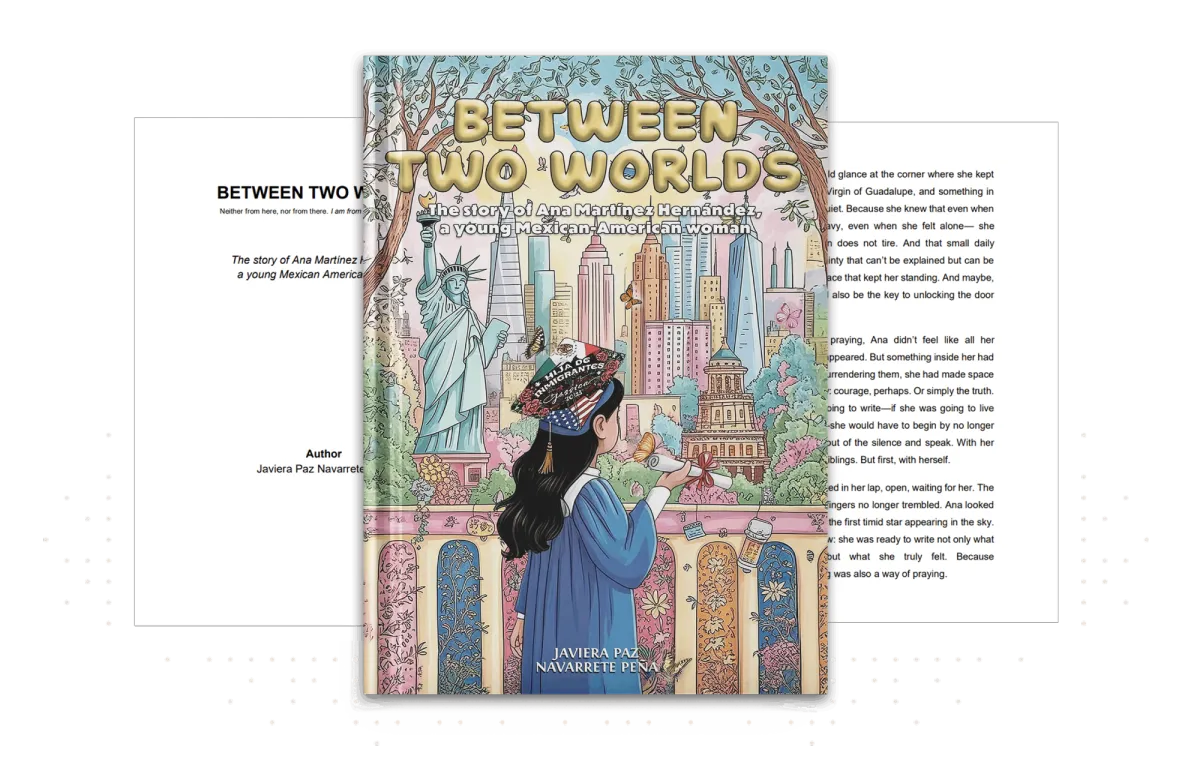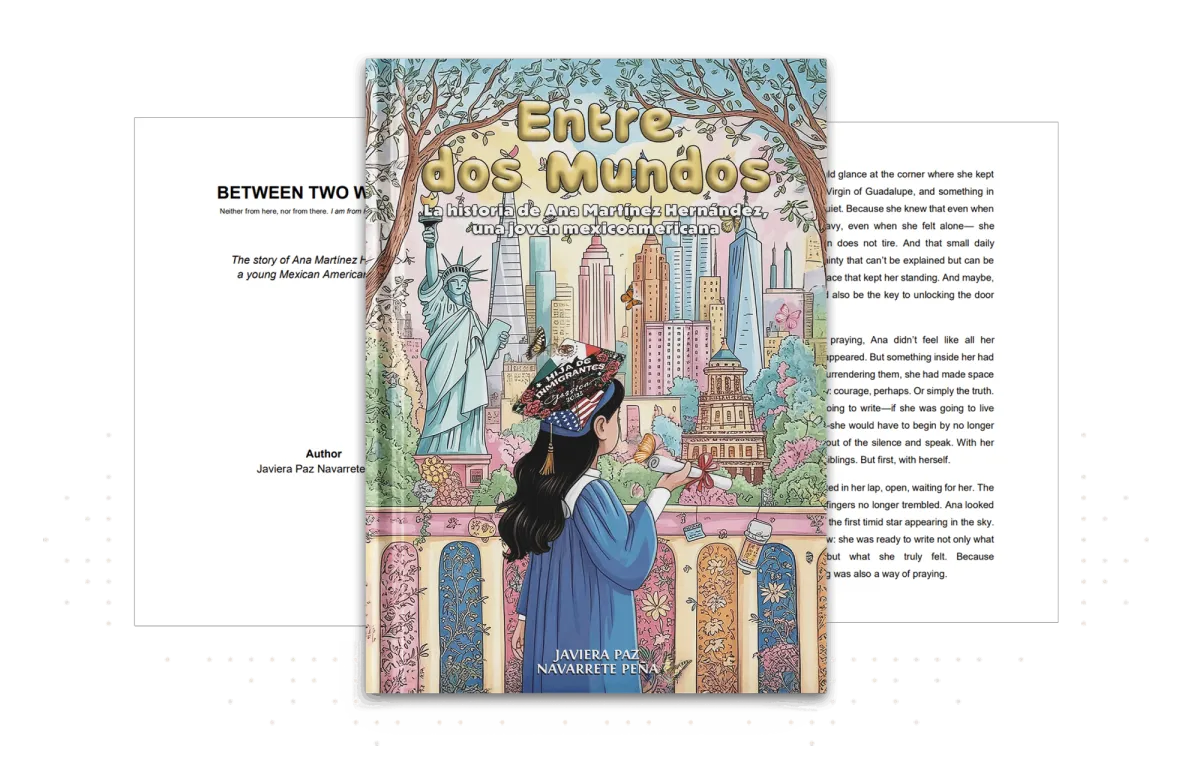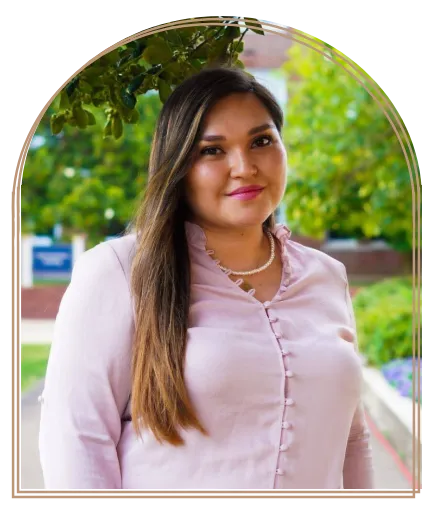
between two worlds
the story of Ana Martínez Hernández,
a young mexican-american woman

Ana Martínez Hernández’s story begins in Memphis, Tennessee, where the melodies of blues intertwine with the warmth of her Mexican roots. Born to immigrant parents who crossed borders with courage and sacrifice, Ana grows up navigating two distinct worlds — the traditions of her family and the fast-paced reality of the United States.
Through Ana’s journey, Entre Dos Mundos explores themes of identity, belonging, faith, and resilience. From her bilingual childhood and struggles with cultural expectations to her pursuit of education and passion for literature, Ana faces the challenges of being “too Mexican” for some and “too American” for others. Her story unfolds as she learns to embrace both worlds, finding strength in her heritage while forging her own path forward.
As Ana becomes a writer, her words give voice to the experiences of her community — immigrants balancing hope and hardship, children bridging generational divides, and families carrying dreams across borders. Her narrative weaves together personal growth, family bonds, and the unyielding power of faith and culture to illuminate a universal truth: our identities are not divided, but enriched, by the worlds we inhabit
Entre Dos Mundos
La historia de Ana Martínez Hernández,
una joven mexicoamericana

Ana Martínez Hernández’s story begins in Memphis, Tennessee, where the melodies of blues intertwine with the warmth of her Mexican roots. Born to immigrant parents who crossed borders with courage and sacrifice, Ana grows up navigating two distinct worlds — the traditions of her family and the fast-paced reality of the United States.
Through Ana’s journey, Entre Dos Mundos explores themes of identity, belonging, faith, and resilience. From her bilingual childhood and struggles with cultural expectations to her pursuit of education and passion for literature, Ana faces the challenges of being “too Mexican” for some and “too American” for others. Her story unfolds as she learns to embrace both worlds, finding strength in her heritage while forging her own path forward.
As Ana becomes a writer, her words give voice to the experiences of her community — immigrants balancing hope and hardship, children bridging generational divides, and families carrying dreams across borders. Her narrative weaves together personal growth, family bonds, and the unyielding power of faith and culture to illuminate a universal truth: our identities are not divided, but enriched, by the worlds we inhabit
Meet
Javiera Paz NaVaRrete Peña
Javiera Paz Navarrete Peña is a Chilean-born author, educator, and communications specialist whose work celebrates identity, culture, and the immigrant experience. Born in Santiago, Chile, in 1986, she graduated with academic honors from Universidad Gabriela Mistral, earning a Bachelor’s in Social Sciences, a degree in Journalism, and a Licentiate in Philosophy. Her passion for language and storytelling led her to continue her studies abroad at Universidad Antonio Nebrija in Spain and Università di Bologna in Italy before completing a Master of Arts in Romance Languages at the University of Memphis.
Javiera’s debut novel, Entre Dos Mundos (Between Two Worlds), is a powerful work of contemporary fiction that explores the complexities of growing up between cultures. Through the story of Ana Martínez Hernández, a young Mexican American navigating faith, family, and identity, Javiera gives voice to the immigrant journey and the challenges of balancing heritage with personal dreams.

blogs
Lorem Ipsum is simply dummy text of the printing and typesetting industry. Lorem Ipsum has been the industry's standard dummy text ever since the 1500s, when an unknown printer took a galley of type and scrambled it to make a type specimen book.

Bridging Language, Culture, and Faith: The Importance of Original and Authentic Materials in Spanish Language Education
Language as a Carrier of Culture and Faith
Language serves as more than a tool for communication; it is a carrier of culture, history, and worldview. As World Language educators, we bear the responsibility of teaching not just grammar and vocabulary but also the cultural contexts that breathe life into the language. This is especially important when considering that for many Hispanic students and communities, Catholicism is a significant aspect of their cultural heritage. How, then, can religious content be incorporated into a world language curriculum?
Integrating Catholicism and Culture in Language Curriculum
The inclusion of religious content in a world language curriculum enhances cultural understanding. Take, for instance, Catholicism's role in Hispanic history, dating back to the colonization of the Americas. Isabella of Castile, known as "Queen Elizabeth the Catholic," played a crucial role in Spain’s exploration and colonization efforts. Catholicism arrived in the Americas alongside the Spanish language and culture, blending with indigenous customs to create a unique cultural identity.
Celebrations such as Our Lady of Guadalupe in Mexico are not merely religious events; they are profound expressions of national identity. Understanding the story of St. Juan Diego and the significance of the Marian apparitions provides a key to grasping the cultural pride and devotion that surrounds this tradition. Similarly, the observance of Las Posadas in Mexico or La Virgen de la Tirana in Chile offers students a lens through which they can see the blending of religious faith with local customs and values. In the Catholic faith, the Virgin Mary appears in many forms, each associated with distinct traditions depending on the region or culture. This diversity within the unity of the Catholic tradition serves as a valuable example of how religion expresses culture. It also highlights how teaching these elements of faith provides a deeper understanding of the language and the people who speak it.
Catholic traditions are not only part of my curriculum but also part of my personal identity. Having grown up in a Catholic school in Chile, these traditions are a vital part of my upbringing. Teaching them in the classroom allows me to share a piece of my culture with my students while offering them an authentic view of Hispanic heritage.
For instance, Día de Muertos (Day of the Dead) is a Catholic celebration with indigenous roots that honors deceased loved ones. When teaching about this celebration, I highlight its religious significance and its different expressions across Hispanic countries. The vibrant altars, sugar skulls, and marigolds offer students a tangible way to engage with the culture. This practice is deeply rooted in faith, reflecting the Catholic belief in the communion of saints and the importance of praying for the souls of the departed.
Another example is El Día de la Candelaria (Candlemas), a Catholic celebration held on February 2nd to mark the end of the Christmas season. It commemorates the presentation of Jesus at the Temple, the purification of the Virgin Mary, and the blessing of candles. In Mexico, the celebration is tied to Rosca de Reyes (Three Kings' Day), where the person who finds a baby figurine hidden in the cake hosts a party on Día de la Candelaria, providing tamales and atole. This day is celebrated with processions and the dressing of Infant Jesus figures, often incorporating indigenous traditions in various regions. Celebrating Rosca de Reyes with my students and discussing the significance of the baby Jesus figures creates a unique cultural moment in the classroom.
Project-Based Learning and Cultural Identity
One of the most effective ways I integrate culture and faith into my teaching is through project-based learning. During Hispanic Heritage Month, for example, I encourage my students to go beyond famous Hispanic figures or countries and explore saints, Catholic traditions, and the historical impact of Catholicism in Latin America. This approach allows students to see how religion and culture intertwine and how Catholicism has shaped Hispanic identity over time.
Students might research how Catholicism arrived in the Americas, a history closely tied to Spanish colonization and missionary evangelization. This historical context is crucial not only for understanding the spread of the Spanish language but also for recognizing the cultural and religious transformations in the region. By including these topics in their projects, students gain a holistic view of Hispanic culture, acknowledging the integral role of faith in shaping both historical and contemporary identities.
Additionally, I teach students how to create presentations on topics related to Hispanic culture and Catholicism, using tools like Google Slides. These projects allow students to practice their language skills while enhancing their presentation abilities.
Faith, Culture, and Language as a Unified Learning Experience
As educators, we have the power to shape how students understand and engage with the world. Incorporating authentic materials that reflect the lived experiences, values, and faith of the communities we teach fosters a learning environment that is inclusive, respectful, and connected to the real world. When teaching Spanish, it is essential to recognize that language, culture, and faith are intertwined. To teach one without the others is to miss the full picture.
In my classroom, I emphasize that Spanish class is not just about learning grammar and vocabulary—it is about exploring culture, history, and faith. By integrating Catholic traditions and authentic cultural materials into the curriculum, I provide students with a rich, meaningful, and comprehensive understanding of the Spanish-speaking world.
Whether through teaching about Las Posadas, or the history of Catholicism in the Americas, my goal is to offer students more than just language skills. I aim to invite them to experience a vibrant, multifaceted culture deeply rooted in faith. Through this approach, my students gain a broader perspective on the world, one that acknowledges the significance of religion in shaping the identities and traditions of the Hispanic communities they are studying.
Javiera Navarrete M.A. – Author, Educator, Advocate for Hispanic Voices Passionate about bilingualism, culture, and storytelling, Javiera writes novels and essays that explore identity, belonging, and the human experience.
📚 Read her novel: Between Two Worlds – [Insert book link]
🌐 Website / Blog: https://booksbyjavi.com/
📸 Instagram: Click Here | Facebook: Click Here | X/Twitter: Click Here
💬 Connect with Javiera and join the conversation about language, culture, and identity.
reader reviews

"My life changed forever"
"Testimonial lorem ipsum dolor sit amet, consectetur adipisicing elit. Autem dolore, alias, numquam enim dolor elit."

— John Doe

"My life changed forever"
"Testimonial lorem ipsum dolor sit amet, consectetur adipisicing elit. Autem dolore, alias, numquam enim dolor elit."

— John Doe

"My life changed forever"
"Testimonial lorem ipsum dolor sit amet, consectetur adipisicing elit. Autem dolore, alias, numquam enim dolor elit."

— John Doe

"My life changed forever"
"Testimonial lorem ipsum dolor sit amet, consectetur adipisicing elit. Autem dolore, alias, numquam enim dolor elit."

— John Doe
get in touch
contact me
Thank you for stopping by. If something here has inspired you, moved you, or sparked a question, I’d love to hear from you.